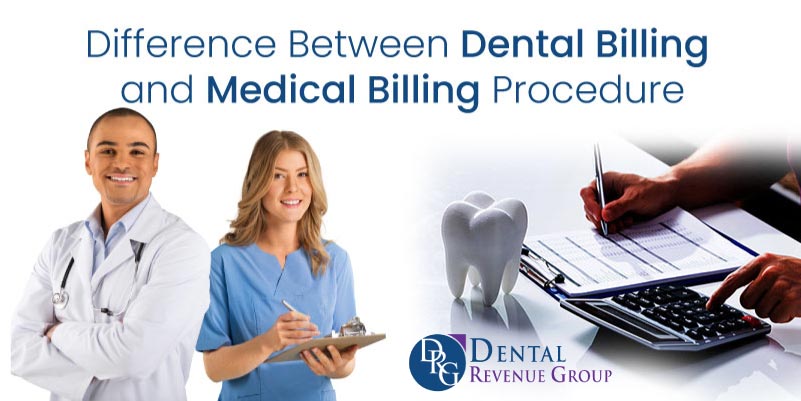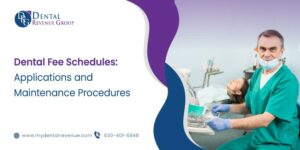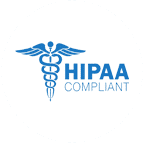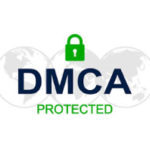Dental billing and medical billing are fundamentally similar in their understanding and concepts. You must understand the fundamental principles of dental billing and coding procedures and how insurance companies receive and pay claims. However, it is critical to understand dental billing and how they differ from the medical billing procedure.
Dental and medical billing information contains data on submitting claims, including appropriate codes, and interacting with insurance companies. The processing systems of these billing systems are somewhat similar, but there are a few differences. Medical billing entails sending invoices for services provided to insurance companies and patients. The medical billing service determines the amount patients are required to pay and any insurance premiums they may have imposed by using diagnostic codes and other data.
Dental billing collects payments from insurance companies and patients for medical services covered by dental billing codes. It entails working with patients to give them insurance cards and collecting payments from them following consultation. Patients are encouraged to speak with their insurance provider to learn more about their coverage. Dental billing is concerned with the business side of dentistry and the reimbursement procedure. You must collect patient information, confirm insurance coverage, ensure that the correct codes are used, and so on. Your billing department must be updated on the most recent changes to the codes used for dental billing.
Is Dental Billing and Medical Billing The Same Thing?
Yes, dental and medical billing are very similar. They are both parts of practice management, but the procedure is different. For example, the dental biller’s job description will include instances when they must consult with their dentist. Similarly, a medical biller may be required to read up on treatment plans to ensure proper coding and billing.
The two have the following features in common.
- In both methodologies, you must understand the fundamental principles and how insurance companies admit and process claims.
- Both billing processes require proper communication with insurance companies.
- In-depth patient demographic data is required.
- Both billings require information about submitting claims, including the correct codes and communicating with insurance companies.
What Are the Differences Between Dental Billing and Medical Billing?
Now we’ve covered the differences between dental billing and medical billing processes, let’s examine the distinctions.
When it comes to dental coding, a diverse set of data is used in sending claims and compiling the coding process. In this regard, medical billing and coding are distinct. Medical coding is determined by three factors: ICD-10, CPT, and HCPCS. The American Dental Association publishes a considerable text called Current Dental Terminology, which is used in dental coding. As a result, the inclusion of codes differs in both medical billing processes. You must handle the codes carefully to receive productive reimbursement in both cases.
Dental billing and coding claim forms are used, like other medical claims. J400 is the name of the dental claim form. This document includes all pertinent information regarding patient demographics, service provision dates, patient insurance coverage, and dental codes. It also provides information about the provider, such as treatment place, fees, and identification. Dental claim forms require a large amount of information. This data may consist of specific tooth surfaces, details about missing teeth, procedure explanations, etc. This information is linked to the patient’s dental procedure.
Dental Billing and Medical Billing Insurance Coverage
When it comes to coverage, medical and dental insurance plans differ from one another. By understanding how your dental insurance benefits work, you’ll be able to make better use of your coverage and save money on out-of-pocket expenses. Dental insurance is distinct from your overall medical insurance. Dental insurance is generally proactive, whereas medical insurance is reactive. Medical insurance is intended to be used after a health problem has arisen, whereas dental insurance is primarily concerned with preventing such issues in the first place.
Patients who do not have the proper insurance will not be reimbursed and have to pay for every healthcare service they receive. As a medical coder, you must be aware of the patient’s insurance coverage and properly integrate it. Most patients believe that their insurance policy includes dental coverage. Medical insurance will most likely pay the bills if a patient receives dental care due to a medical problem. The patient must discuss with the dental billing and coding departments to determine whether their current insurance covers their required dental services.
Medical and Dental Billing Codes
In contrast to medical billing and coding, dental coding sends claims using various data. The three most common languages are:
- ICD-9
- HCPCS
- CPT
Instead, the American Dental Association updates and publishes current dental terminology (CDT). The main difference between dental and medical coding is CDT.
Dental codes stated by hygienists or other dental professionals in combination with various CDT code categories are not permitted by CDT. Another significant difference between dental and medical coding systems is the time and frequency with which updates, removals, and revisions are made. All medical code sets are updated yearly, and most medical carriers do not provide time limits for using outdated codes.
Are There Different Reimbursement Rates For Medical and Dental Claims?
Yes! Medical claims are typically reimbursed more slowly than dental practices. Furthermore, medical plans usually include higher deductibles. Many medical plans also need referrals; therefore, you’ll need to confirm the patient’s coverage. This should ideally be done during your insurance verification process before the day of their treatment. If you plan to file a medical claim, there will be a little more paperwork involved before the patient’s service. The practice must notify the insurance company and determine what information they require. When in doubt, inquire! The insurance company should provide everything you need to know.
Conclusion
You now understand the fundamental similarities and differences between dental billing and medical billing processes. Dental billing procedures are more complicated than medical billing procedures. Insufficient knowledge of the dental billing process can cause problems with insurance claim approval.
Outsourcing the dental billing process is the best approach. We can successfully handle your complex dental billing tasks while increasing your revenue streams. We are a low-cost solution that promises to deliver high-value results. Focus on saving your money and time by contacting us whenever you want.











